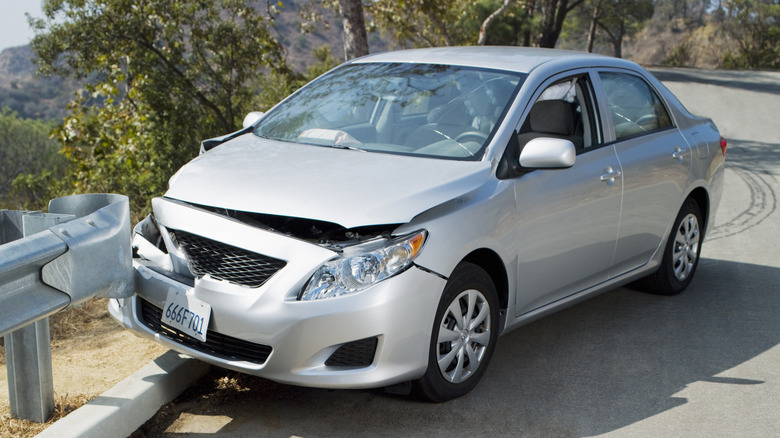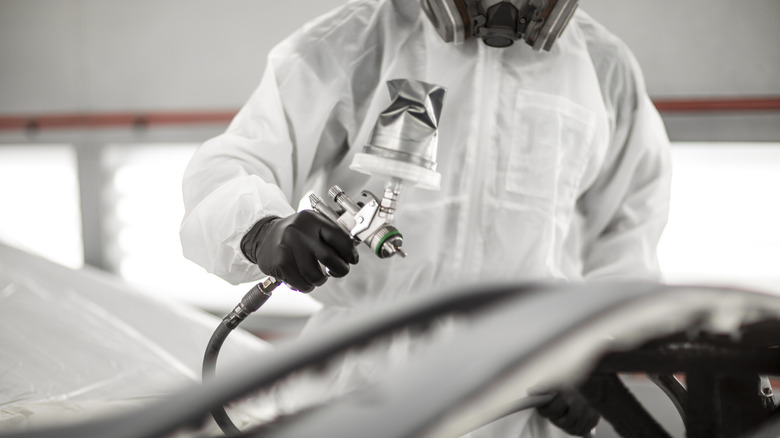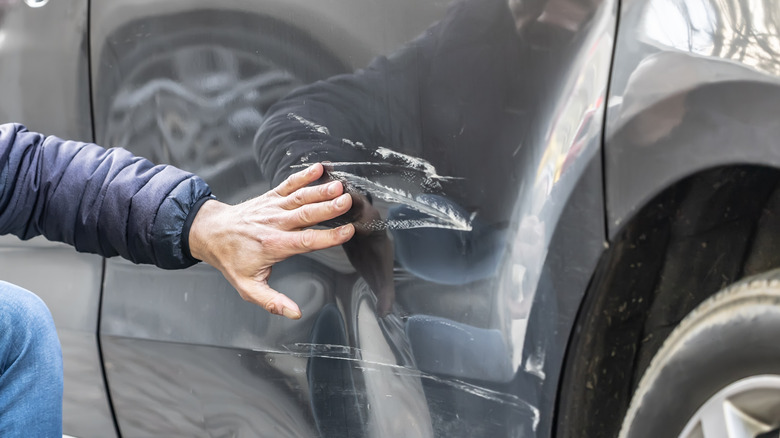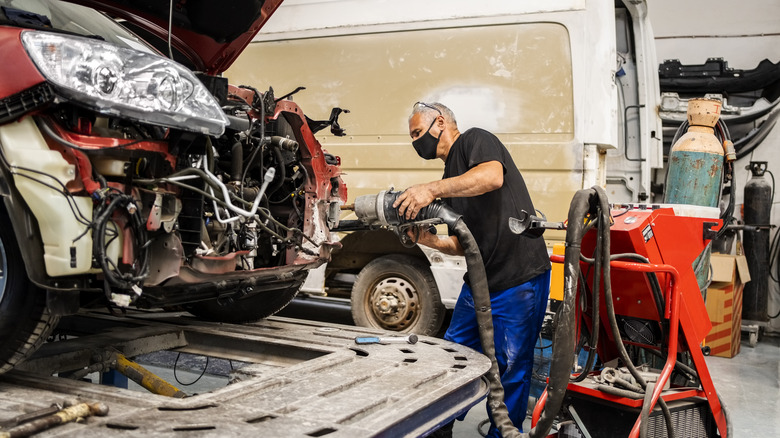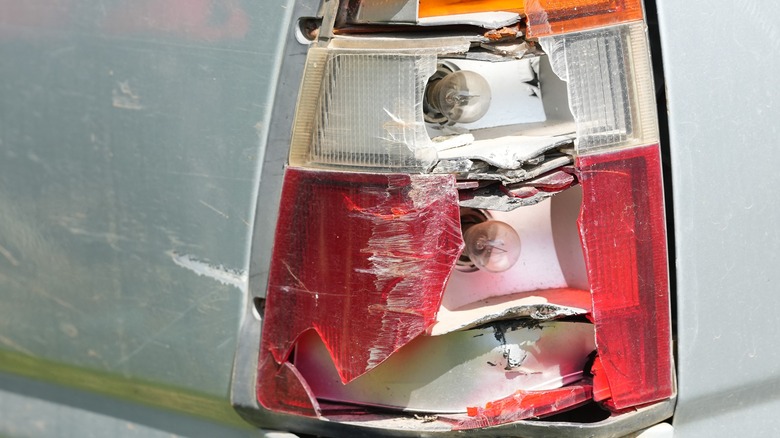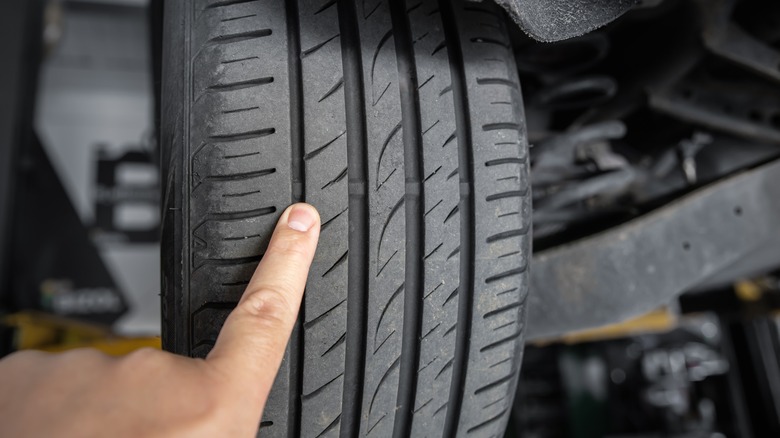5 Ways To Tell If A Car Has Been In An Accident
Most of the time, when you're shopping for a used car, you're seeing vehicles that previous owners sold or traded into the dealer you're browsing at. Now, everyone has their own reasons for selling their car, whether they just needed some cash or they were planning on getting something new, and outside of extenuating circumstances, the exact why of it doesn't really matter to you. It's when a car is sold within those extenuating circumstances that there may be some cause for caution.
Specifically, if a car was sold to a dealer after an accident in poor condition, then it's very possible that it may still have some problems that you'd have to put up with if you bought it. These problems can range from minor annoyances to severe malfunctions, depending on how scrupulous the dealer is, but it shouldn't be on you to deal with any of them. To ensure that a busted car doesn't become your problem, you should give a used vehicle a thorough inspection for any signs of accident-induced damage. If you spot any of these red flags, you should either ask for more detailed documentation or just look elsewhere.
Unusual paint jobs
When a car first leaves the factory, it's got a nice, even coat of paint across all of its external panels. Obviously, though, even a minor accident is going to mess up that nice paint job something fierce. After a car is repaired following an accident, at least a token effort may be made to touch up the paint and cover up any visible damage. This can both downplay existing issues and just generally make the car look kind of lousy.
Take a good look at the circumference of the car's body. Even if it's got a few years under its belt, its paint should still be consistent and glossy. If you spot any discoloration, dullness, or weird physical textures, that's a sign that a half-baked paint touch-up has been applied. Even if this paint is meant to cover up a single scratch, that's a scratch that someone was trying to hide from you.
Misaligned panels
Every panel on a car's body is designed to fit together perfectly like a puzzle. A brand-new car looks as sleek as it does because there's no wear or widening on the gaps between the panels. However, if a car is subjected to an intense burst of physical force, such as in a crash, those panels can be knocked out of alignment. Even the slightest nudge to one side of a body panel can expose a small, yet distinctive gap, kind of like a jigsaw puzzle piece with one of the ends cut off.
As you inspect a potential used car purchase, try and find any distinctive gaps in the panels that you can. Run your finger along the spaces between the doors, the sides of the hood, and around the lights, and also give the doors a few experimental opens and closes. If the panels are out of alignment, the spaces will be much larger and distinctive, and on the doors specifically, they may even bump against each other when opening. If those panels are out of alignment, that means the body is compromised, which means more problems are borderline inevitable.
Inconsistent welding
Similarly to the panels, any signs of welding performed on the car by its original manufacturer should be nearly invisible, or at least very subtle. Welding with a precision assembly line is much different from one guy waving around an acetylene torch, after all. If, during your initial inspection of a used car, you spot any signs of uneven or slapdash welding on the body or on the internal components, that's a bad sign.
As opposed to subtle welding from the factory, after-market welding is usually performed to forcefully attach parts onto the car's body, usually in the event that the original parts were lost or damaged in an accident. Panels and parts that have been haphazardly welded to the body are neither safe nor resilient; since they weren't a part of the car's original construction, it may only take one good jostle in the wrong place to send everything flying. Being in a regular accident would be bad enough, but if your entire car fell apart with you in it, that's a recipe for chaos and medical bills.
Off-market parts
On the subject of slapdash reconstruction, a red flag to be on the lookout for in used cars is off-market parts. When a car has been in an accident, a garage may not have access to all of the authentic parts used in its original construction, so instead they use some off-market knock-offs to Frankenstein it back together. If you see any parts of the car that look like they obviously don't belong, especially things like tail lights and airbag covers, it's probably because they don't.
Granted, enthusiasts will sometimes make off-market modifications to their vehicles for fun or fashion, though those kinds of passion project cars don't usually end up on the used lot. In all likelihood, these kinds of replacements were made to save a few bucks on a post-accident patch job. Off-market parts have neither the resilience nor safety guarantee of official components, which means driving a car with them could be dangerous. Besides that, have you ever seen a white car with a big, off-colored panel welded to the front? It's just kind of tacky.
Alignment problems
If your pass over a used car doesn't turn up any obvious problems, don't assume it's ready to go home with you just yet. You need to take it out for a test drive first; small cosmetic damages can be covered up well enough, but if an accident caused lasting damage to the vehicle's vital internal components, that's something you need to know about.
One big thing you should be on the lookout for during your test drive is any problems with the car's alignment. You should be able to keep it driving in a straight line without any particular effort, but if it's listing to the side or otherwise fighting your control, that's a sign that the car isn't roadworthy. Even if it doesn't seem like a severe problem at the moment, the odds are good that if you buy it and drive it for a while, that misalignment is only going to get worse.
